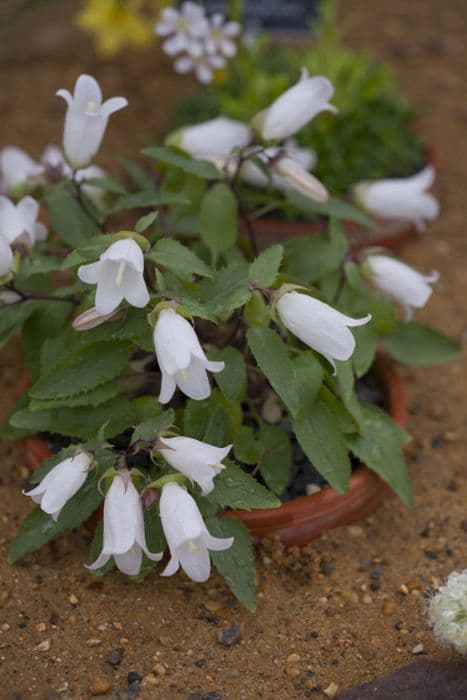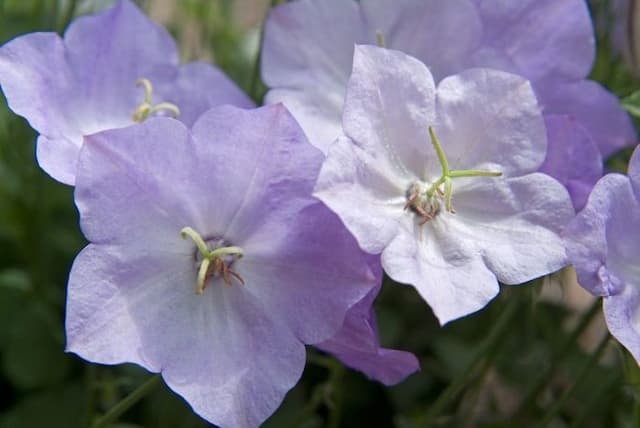Lady's Thimble Campanula thyrsoides

ABOUT
The plant, commonly known as the torch bellflower, boasts a unique and striking appearance. It is characterized by its dense, spike-like clusters of bell-shaped flowers, which range in color from a pale yellow to a rich creamy hue. These blossoms are tightly packed together on the flowering spike, creating a visually impactful display that somewhat resembles a torch, hence the name. The flowers are further accentuated by their prominent stamens which extend outward, lending the blossoms a slightly starry appearance. The foliage of the torch bellflower is typically a vivid green, forming a basal rosette of lance-shaped leaves. These leaves are often glossy and can have slightly serrated edges, providing a lush backdrop for the towering blooms. The overall shape of the plant is upright, with flower spikes rising above the basal leaves in a showy, vertical fashion. The torch bellflower has a robust and sturdy stem that holds the flower spikes aloft. Its growth habit and the bold arrangement of its flowers make it a favorite among gardeners looking to add vertical interest to their plantings. This plant blooms in the summer and attracts a variety of pollinators, including bees and butterflies, who are drawn to its flowers for nectar and pollen. The visual appeal of the torch bellflower is further enhanced when it is planted in groups, as the mass of flowering spikes creates a sea of color that can be a stunning sight in any landscape or garden setting.
About this plant
 Names
NamesSynonyms
Lady's Thimble, Clustered Bellflower
Common names
Campanula fragilis, Campanula thyrsoides var. fragilis, Campanula mediterranea, Campanula medium.
 Toxicity
ToxicityTo humans
The Campanula thyrsoides, commonly known as the Meadow Bells, is not typically recognized as a toxic plant to humans. There is no well-documented evidence of toxicity in this species that would cause concern for humans upon ingestion. Therefore, it is not typically associated with any symptoms of poisoning or adverse health consequences for humans consuming parts of this plant.
To pets
Similarly for pets, Meadow Bells are not widely known to be toxic. There is no significant evidence to suggest that consumption of Campanula thyrsoides causes poisoning or is harmful to pets like dogs and cats. Hence, ingesting parts of this plant is not commonly linked to any symptoms of toxicity or detrimental health effects in pets. However, it is always advisable to monitor pets for any signs of allergic reactions or gastrointestinal upset when they consume any plant material, as individual sensitivity may vary.
 Characteristics
CharacteristicsLife cycle
Perennials
Foliage type
Deciduous
Color of leaves
Green
Flower color
Yellow
Height
1-2 feet (30-60 cm)
Spread
1 foot (30 cm)
Plant type
Herb
Hardiness zones
5
Native area
Europe
Benefits
 General Benefits
General Benefits- Aesthetic Appeal: The tower of stars, with its characteristic yellow or cream flower spikes, adds visual interest and beauty to gardens and landscapes.
- Low Maintenance: Once established, it requires minimal care, making it suitable for gardeners of all skill levels.
- Attracts Pollinators: The flowers attract bees and other beneficial pollinators, supporting local ecosystems.
- Long Blooming Period: It has a lengthy flowering season, often lasting several weeks, providing color and vibrancy for extended periods.
- Adaptability: Tower of stars can adapt to a variety of soil types, although it prefers well-drained, chalky substrates.
- Drought Tolerance: It is relatively drought-tolerant once established, making it suitable for xeriscaping in drier climates.
- Edging Plant: Its compact growth makes it ideal for use as an edging plant along borders or pathways.
- Rock Gardens: Its suitability for alpine and rock gardens makes it a valuable plant for themed landscaping projects.
- Container Gardening: It can thrive in pots and containers, providing flexibility for gardeners with limited space.
 Medical Properties
Medical PropertiesThis plant is not used for medical purposes.
 Air-purifying Qualities
Air-purifying QualitiesThis plant is not specifically known for air purifying qualities.
 Other Uses
Other Uses- Campanula thyrsoides, commonly called "Lady's Thimble", can be used in dried flower arrangements due to its long-lasting blooms which retain their color and form.
- As an ornamental feature in Alpine rock gardens, Lady's Thimble adds a vertical accent due to its tall, spike-like flower clusters.
- In educational settings, this plant can be utilized to teach about alpine flora and its adaptations to high-mountain environments.
- Gardeners may use Lady's Thimble as a living support for climbing plants or vines that appreciate a bit of assistance.
- Due to its eye-catching flowers, Lady's Thimble can be grown for artistic inspiration and is often featured in botanical illustrations.
- The plant can be part of a sensory garden, where its soft petals provide a tactile experience.
- Lady's Thimble can be incorporated into a butterfly or pollinator garden as it attracts bees and other insects.
- Culinary artists can use the flowers of Campanula thyrsoides as an organic garnish for plating desserts and salads for an elegant touch.
- In photography, the unique shape and color of Lady's Thimble can make it a subject of interest in macro photography.
- Ecological studies may use this plant as an indicator species to understand the health of alpine habitats where it naturally grows.
Interesting Facts
 Feng Shui
Feng ShuiThe plant Thyrsoides is not used in Feng Shui practice.
 Zodiac Sign Compitability
Zodiac Sign CompitabilityThe plant Thyrsoides is not used in astrology practice.
 Plant Symbolism
Plant Symbolism- Endurance: The campanula thyrsoides is known for its resilient nature, symbolizing the ability to endure and thrive through difficulties.
- Constancy: With its long-lasting blooms, it embodies loyalty and the constant beauty found in life, representing unchanging feelings and faithfulness.
- Gratitude: Offering campanula thyrsoides may express appreciation and thankfulness towards another person, due to the flower's pleasing appearance and perennial growth.
- Humility: The bell-shaped flowers, which tend to face downwards, are commonly associated with humility and the willingness to be unassuming or modest.
- Youthful love: The fresh and bright appearance of the flowers can signify the innocence and joyful aspects of young love or early relationships.
 Water
WaterThe Lady’s Thumb or Alpine Bells should be watered thoroughly once the top inch of soil feels dry to the touch. This typically means watering once a week, but may vary depending on environmental conditions. It is better to water the plant deeply and less frequently to encourage root growth. Provide around half a gallon of water for a medium-sized plant, ensuring that the water penetrates the soil and doesn’t just run off the surface. Always allow the excess water to drain to prevent waterlogging, which could damage the plant.
 Light
LightLady’s Thumb thrives best in full sunlight to partial shade conditions. The plant will bloom most abundantly when it receives at least 6 to 8 hours of direct sunlight each day. An ideal spot would be in a garden bed that gets ample morning sun with some protection from the intense afternoon sun, or somewhere that receives dappled shade throughout the day.
 Temperature
TemperatureThe ideal temperature range for the Lady’s Thumb is between 60 to 75 degrees Fahrenheit. While it can tolerate temperatures down to around 50 degrees Fahrenheit, and up to about 80 degrees Fahrenheit, it's best to avoid exposing the plant to extreme heat or frost. Keeping the plant within this temperature range ensures healthy growth and flowering.
 Pruning
PruningPruning the Lady’s Thumb is essential to maintain its shape and encourage healthier, more robust growth. Cut back the faded flowers after blooming to promote a second flush of blooms. Prune lightly in the early spring to remove any dead or damaged growth. The best time for a more thorough pruning is immediately after flowering, but always ensure that some foliage remains for photosynthesis.
 Cleaning
CleaningAs needed
 Soil
SoilThe best soil mix for the plant commonly known as tower bellflower is one that is well-draining with a good mix of loam, peat, and sand. The ideal pH for tower bellflower is slightly alkaline, around pH 7.0 to 8.0.
 Repotting
RepottingTower bellflower should be repotted every two to three years to refresh the soil and accommodate root growth.
 Humidity & Misting
Humidity & MistingTower bellflower prefers moderate humidity levels, avoiding both overly dry and excessively moist air conditions.
 Suitable locations
Suitable locationsIndoor
Ensure bright indirect light, cool temps, and well-draining soil.
Outdoor
Plant in well-drained soil, full sun to partial shade, protect from harsh winds.
Hardiness zone
4-9 USDA
 Life cycle
Life cycleCampanula thyrsoides, commonly known as the Lady’s Thimble, begins its life cycle as a seed that germinates in early spring, requiring a period of cold stratification to break dormancy. The seedlings develop into a basal rosette of lanceolate leaves, experiencing vegetative growth during the first year. In its second year, the plant sends up a tall flowering stalk, which bears densely packed, bell-shaped yellowish or whitish flowers that attract pollinators and facilitate cross-pollination. After flowering, typically from June to August, the plant produces dry, capsule-like fruits containing small seeds that are dispersed by wind. The parent plant dies after seed production, completing its biennial life cycle. The new seeds lie dormant through winter until the next suitable growth period arrives, repeating the cycle.
 Propogation
PropogationPropogation time
Spring to summer
Propogation: The most popular method of propagating the Clustered Bellflower, or Campanula thyrsoides, is by seeds. The best time for sowing seeds is in the spring, after the danger of frost has passed. Typically, gardeners will sow the seeds directly into the soil where they intend the plants to grow, as this plant does not always take well to transplanting. The seeds require light to germinate, so they should be sprinkled onto the soil surface and not covered, or covered only lightly with a fine layer of soil. Moisture is key, so the soil should be kept evenly moist but not waterlogged until germination, which can take 14 to 21 days. Once seedlings have emerged and are sturdy enough, thinning may be necessary to provide ample space for the plants to develop.









![Milky bellflower [Avalanche]](/_next/image?url=https%3A%2F%2Fplants-admin.emdemapps.com%2Fimages%2Fplants%2F%2Fimages%2F604b5dc88c1e7.png&w=640&q=75)